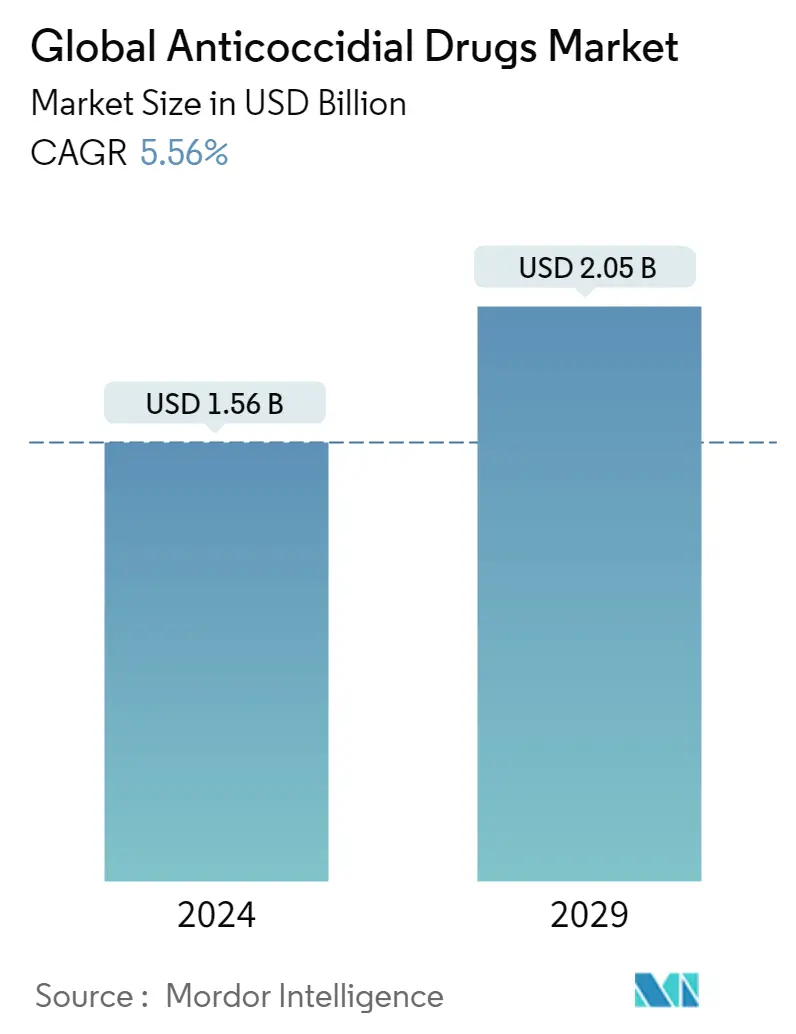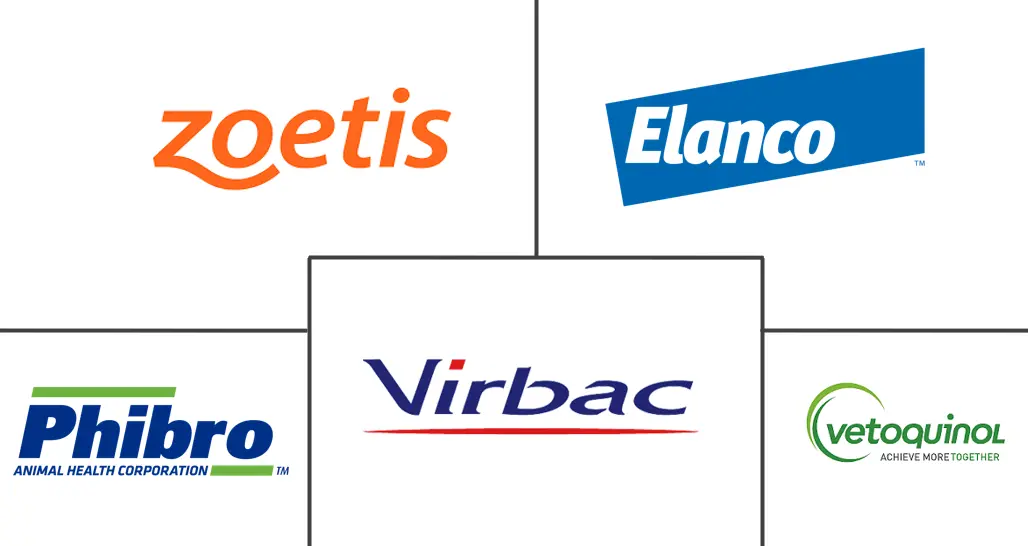Market Size of Global Anticoccidial Drugs Industry

| Study Period | 2019 - 2029 |
| Market Size (2024) | USD 1.56 Billion |
| Market Size (2029) | USD 2.05 Billion |
| CAGR (2024 - 2029) | 5.56 % |
| Fastest Growing Market | Asia-Pacific |
| Largest Market | North America |
Major Players
*Disclaimer: Major Players sorted in no particular order |
Anticoccidial Drugs Market Analysis
The Global Anticoccidial Drugs Market size is estimated at USD 1.56 billion in 2024, and is expected to reach USD 2.05 billion by 2029, growing at a CAGR of 5.56% during the forecast period (2024-2029).
Due to the COVID-19 outbreak, a short-term negative impact was seen on the market due to decreased visits to veterinary hospitals and clinics. Healthcare services were significantly reduced due to social distancing measures taken by governments across the globe. According to a February 2021 article published in Frontiers in Veterinary Science, dog owners also feared the COVID-19 infection and its spread, leading to fewer disease diagnoses for pets. Additionally, the study above also indicated that, like many other professions, veterinarians were significantly impacted by the onset of COVID-19 in the initial phase of the pandemic. However, the pandemic drove pet owners to email, text, and even video call veterinarians on a scale never seen before. The number of veterinarians offering digital or remote consultations increased by 20% as a result of the pandemic, with almost half of the veterinarians (47%) offering online services. This surge in interest and demand for online veterinary services is rapidly changing the pet care landscape.
A significant burden of coccidiosis in animals across the globe is expected to boost the market. Coccidiosis is one of the most severe enteric problems in the poultry industry. The most catastrophic Eimeria tenella outbreaks occurred in the early stages of intensive chicken farming. The coccidia species Eimeria tenella produces severe hemorrhages and hypovolemic shock, both of which are fatal for the infected bird. However, subclinical coccidiosis is responsible for an even greater proportion of production losses caused by damage to intestinal cells which further leads to decreased body weights, increased feed conversion rates, a lack of flock uniformity, difficulties with skin pigmentation, and, in the end, mortality.
Moreover, Eimeria is a genus of apicomplexan parasites that includes various species capable of causing the disease coccidiosis in animals such as cattle, poultry, dogs, cats, and smaller ruminants, including sheep and goats. According to a research article published in August 2022 by Anthony Andrew, nearly 20 or more Eimeria species have been identified in cattle feces worldwide. According to the article, clinical infection usually begins at 1-2 months of age because coccidiosis rarely manifests in the first three weeks of life. Thus, the burden of coccidiosis among the target animals of a specific age demands the availability of the anticoccidial drugs. As a result, market growth is expected during the analysis period.
A significant rise in the adoption of pet animals, including dogs, cats, and even horses, as companions of human beings, has been observed over recent years. Furthermore, farm animals such as cattle and swine are being taken in for a variety of commercial reasons. Because of their promising economic conditions, industrialized economies account for a disproportionately significant share of animal ownership. For instance, according to the 2022 published data by the Pet Food Manufacturers Association (United Kingdom), 17.4 million or 62% households in the United Kingdom owned pets in 2022. As the pet owners are more concerned and aware of the safety of their pets, this is likely to create demand for preventive and curative advanced therapeutic products, thereby boosting the market growth.
While these factors are expected to propel the growth of the studied market over the forecast period, the availability of alternative treatment methods in the market is anticipated to hamper the market growth.
Anticoccidial Drugs Industry Segmentation
As per the scope of the report, coccidiosis is one of the most frequent and prevalent parasitic diseases among animals. Its symptoms include weight loss, mild intermittent to severe diarrhea, feces containing mucus or blood, dehydration, and decreased breeding. Any drug used to combat the progression of coccidiosis in birds or animals, both food-producing and non-food producing, is termed an anticoccidial drug.
The Anticoccidial Drugs Market is segmented by Drug Type (Ionophore, Antibiotic, Sulphonamides, Chemical Derivative, and Others), Drug Action (Coccidiostatic and Coccidiocidal), Animal (Livestock Animals, and Companion Animals), Distribution Channel (Veterinary Hospitals, Retail Pharmacy, and Others), and Geography (North America, Europe, Asia-Pacific, Middle East and Africa, and South America). The market report also covers the estimated market sizes and trends for 17 countries across major regions globally. The report offers the value (in USD million) for the above segments.
| By Drug Class | |
| Ionophore | |
| Antibiotic | |
| Sulphonamides | |
| Chemical Derivative | |
| Other Drug Classes |
| By Drug Action | |
| Coccidiostatic | |
| Coccidiocidal |
| By Animal | |||||
| |||||
|
| By Distribution Channel | |
| Veterinary Hospitals | |
| Retail Pharmacy | |
| Other Distribution Channels |
| Geography | ||||||||
| ||||||||
| ||||||||
| ||||||||
| ||||||||
|
Global Anticoccidial Drugs Market Size Summary
The anticoccidial drugs market is poised for significant growth, driven by the increasing prevalence of coccidiosis in various animal populations, including poultry, cattle, and companion animals such as dogs and cats. The market is expected to expand steadily over the forecast period, supported by the rising adoption of pets and the growing awareness among pet owners regarding animal health. The demand for anticoccidial drugs is further bolstered by the economic benefits they offer in preventing production losses in the poultry industry and improving the health and productivity of livestock. The shift towards digital veterinary services during the COVID-19 pandemic has also contributed to changing pet care dynamics, enhancing the demand for advanced therapeutic products.
North America currently leads the anticoccidial drugs market, with a strong presence of pet ownership and increased spending on animal healthcare. The region's market growth is fueled by the high adoption rates of companion animals and the subsequent need for effective coccidiosis treatments. The competitive landscape of the market is characterized by the presence of major players who are actively engaged in product development and strategic partnerships to enhance their market position. Innovations such as natural alternatives to antibiotics and immune-modulating biologics are also emerging, reflecting the industry's focus on developing advanced solutions to combat coccidiosis in animals.
Global Anticoccidial Drugs Market Size - Table of Contents
-
1. MARKET DYNAMICS
-
1.1 Market Overview
-
1.2 Market Drivers
-
1.2.1 Increased Incidence of Coccidiosis Globally
-
1.2.2 Advancements in Veterinary Healthcare
-
-
1.3 Market Restraints
-
1.3.1 Availability of Alternative Treatment Options in the Market
-
-
1.4 Porter's Five Forces Analysis
-
1.4.1 Threat of New Entrants
-
1.4.2 Bargaining Power of Buyers/Consumers
-
1.4.3 Bargaining Power of Suppliers
-
1.4.4 Threat of Substitute Products
-
1.4.5 Intensity of Competitive Rivalry
-
-
-
2. MARKET SEGMENTATION (Market Size by Value - USD million)
-
2.1 By Drug Class
-
2.1.1 Ionophore
-
2.1.2 Antibiotic
-
2.1.3 Sulphonamides
-
2.1.4 Chemical Derivative
-
2.1.5 Other Drug Classes
-
-
2.2 By Drug Action
-
2.2.1 Coccidiostatic
-
2.2.2 Coccidiocidal
-
-
2.3 By Animal
-
2.3.1 Livestock Animals
-
2.3.1.1 Cattle
-
2.3.1.2 Poultry
-
2.3.1.3 Other Livestock Animals
-
-
2.3.2 Companion Animals
-
2.3.2.1 Dogs
-
2.3.2.2 Cats
-
2.3.2.3 Other Companion Animals
-
-
-
2.4 By Distribution Channel
-
2.4.1 Veterinary Hospitals
-
2.4.2 Retail Pharmacy
-
2.4.3 Other Distribution Channels
-
-
2.5 Geography
-
2.5.1 North America
-
2.5.1.1 United States
-
2.5.1.2 Canada
-
2.5.1.3 Mexico
-
-
2.5.2 Europe
-
2.5.2.1 Germany
-
2.5.2.2 United Kingdom
-
2.5.2.3 France
-
2.5.2.4 Italy
-
2.5.2.5 Spain
-
2.5.2.6 Rest of Europe
-
-
2.5.3 Asia-Pacific
-
2.5.3.1 China
-
2.5.3.2 Japan
-
2.5.3.3 India
-
2.5.3.4 Australia
-
2.5.3.5 South Korea
-
2.5.3.6 Rest of Asia-Pacific
-
-
2.5.4 Middle East & Africa
-
2.5.4.1 GCC
-
2.5.4.2 South Africa
-
2.5.4.3 Rest of Middle East and Africa
-
-
2.5.5 South America
-
2.5.5.1 Brazil
-
2.5.5.2 Argentina
-
2.5.5.3 Rest of South America
-
-
-
Global Anticoccidial Drugs Market Size FAQs
How big is the Global Anticoccidial Drugs Market?
The Global Anticoccidial Drugs Market size is expected to reach USD 1.56 billion in 2024 and grow at a CAGR of 5.56% to reach USD 2.05 billion by 2029.
What is the current Global Anticoccidial Drugs Market size?
In 2024, the Global Anticoccidial Drugs Market size is expected to reach USD 1.56 billion.

